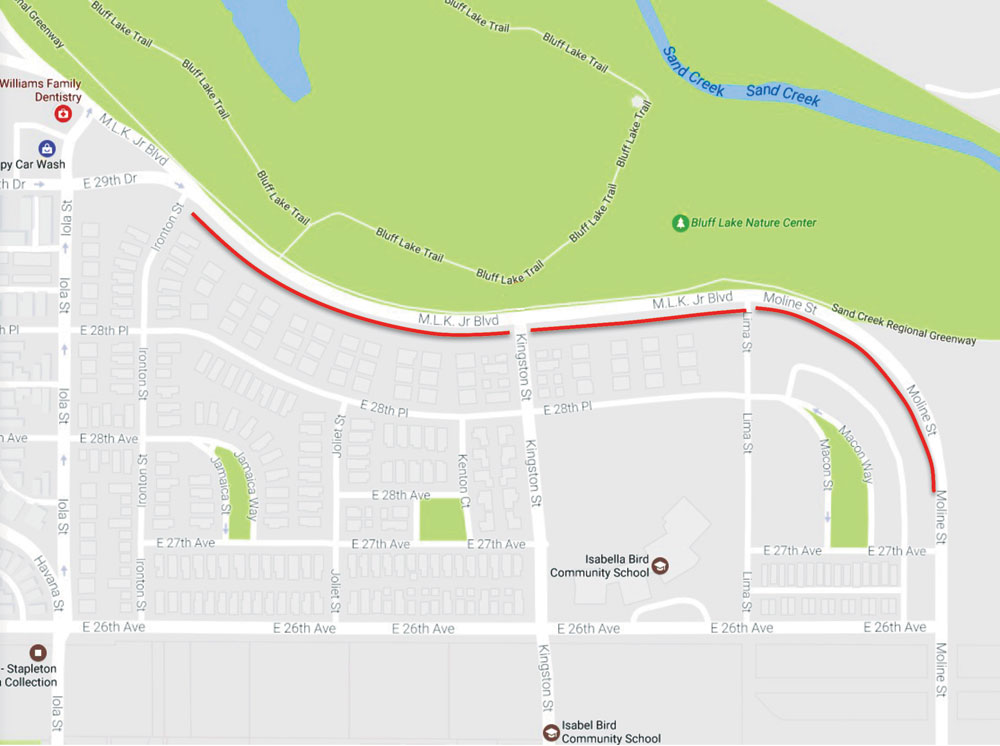
Residents and tenants near a recommended noise wall (location identified by red line) will soon be voting on whether to actually construct the wall. The wall would extend from Ironton Street to where Moline Street runs north and south. Federal and state agencies have concluded the wall is necessary to mitigate the impact of noise from increased traffic on MLK Blvd. once it is extended east to Peoria Street.
The Colorado Department of Transportation (CDOT) and the Federal Highway Administration (FHWA) have concluded that noise walls on the south side of MLK from Ironton St. to Moline St. are a “reasonable and feasible” means for mitigating noise impacts on adjacent residences in that three-block stretch. Under the state and federal protocols, a vote by affected property owners and residents will determine whether the noise walls would actually be constructed.
The cost of the walls, which could vary in height between 8 feet and 12 feet, is roughly estimated at $1 million–$1.3 million. Denver would be responsible for funding the wall construction but has not yet identified a source of funding to pay for the walls.
The MLK project will extend the four-lane arterial roadway from Havana St. east to Peoria St. where it will align with Fitzsimons Parkway at the Peoria St. intersection. (See the March and December 2016 Front Porch for more details on the proposed improvements.) Total project cost is estimated at $16.5 million not counting the noise walls. The project is funded approximately half by Denver and half by a federal grant.
The federal monies trigger an “environmental assessment” (EA) and make the project subject to federal environmental regulations including noise limits. Denver, as the project sponsor, commissioned a noise analysis that found the subject properties would suffer a substantial increase in noise impacts due to the roadway project. Saying the EA is still in draft form, Denver Public Works staff were unable to specify the impact in decibels. However, CDOT’s website says “substantial increase impact occurs when there is a projected 10-decibel increase over existing noise levels. Impacts such as these require mitigation consideration and analysis, which will result in the construction of noise barriers if they are determined to be feasible and reasonable.”
Evidently, much of the discussion between Denver, CDOT and FWHA has revolved around whether noise walls at this location are “feasible and reasonable.” CDOT’s website states: “A barrier is feasible if it can be constructed without major engineering or safety issues and provide a substantial noise reduction to the adjacent receivers. Reasonableness deals with whether the barrier can be designed to achieve a noise reduction design goal of 7 decibels, whether the barrier can be constructed in a cost-efficient manner, and the desires of the community. All three of these criteria must be met for a barrier to be considered reasonable to build.”
Denver contested the finding of feasibility and reasonableness on several grounds including:
A solid noise wall constructed between the planned sidewalk along MLK Blvd. and the existing townhomes would preclude direct sidewalk access to new RTD bus stops near Kingston St. and Moline St. and require pedestrians to walk around the walls to reach the bus stops.
- A solid noise wall would also preclude direct access to the new parking spaces along the south side of the MLK Blvd. extension, requiring people to walk around the walls and over longer distances to reach their destination.
- A noise wall would cause sidewalk shading, resulting in the potential for icing during winter months.
- Noise walls could be considered graffiti targets.
- Noise walls would partially-to-completely block the views to the north of the open space and parklands along the MLK extension.
Stapleton redevelopment follows design standards in the “Stapleton Green Book” and noise walls are inconsistent with these design guidelines. Along these lines, existing portions of MLK to the west of this project area were constructed without noise walls.
Bar Chadwick, Denver’s special projects manager for Stapleton, says in the end, Denver agreed to the finding of feasibility and reasonableness to prevent further delays in the project that was originally slated to begin construction last summer. Otherwise, she said, the “conversations could have gone on forever.”
Denver Public Works is preparing a “public outreach” process for working with the affected property owners and residents, including how the voting will occur. While details of the public outreach process remain to be worked out, the voting test itself is straightforward: if 50 percent or more of the residents/owners vote “no,” then noise walls would not be required and would not be designed into the MLK Jr. Extension project. Conversely, a “yes” vote of 50 percent or more would trigger the requirement for a noise wall.
The “benefitting receptors” (affected property owners and/or current tenants) will be voting on the noise wall location and height but not the colors or materials of the noise walls. Those aspects of the design would be addressed later if the vote supports inclusion of the walls as a project element.
DPW staff estimate that the public outreach process will add two months to the timeline for completing the EA and requesting federal issuance of a “FONSI” or Finding of No Significant Impact. Until CDOT and FHWA sign off on the FONSI, the project cannot move forward.
Denver still hopes to get the project under construction this year and estimates a one-year construction period. The project was originally slated to begin construction summer of 2016 but has been delayed because of the noise wall issue and the need to update traffic modeling.



0 Comments